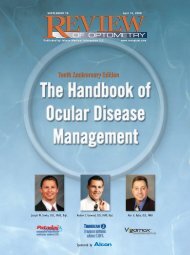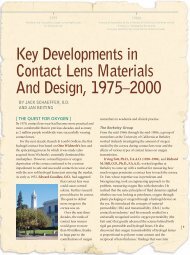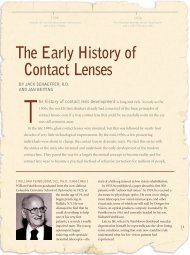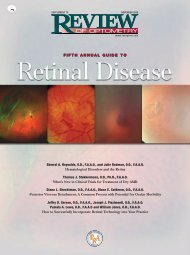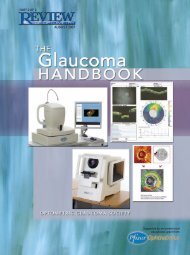You also want an ePaper? Increase the reach of your titles
YUMPU automatically turns print PDFs into web optimized ePapers that Google loves.
1823<br />
John Herschel proposes a glass capsule filled with animal jelly<br />
to correct astigmatism.<br />
1880s<br />
Adolph Fick, Eugene Kalt, and August Müller independently invent<br />
the first glass contact lenses.<br />
Like many pioneers, Dr. Feinbloom had a strong<br />
entrepreneurial spirit. In the 1930s, he developed the<br />
Feincone system for fitting scleral lenses and sold the trial<br />
lens sets to optometrists all over the country.<br />
“When I started practice in 1947, I tried to fit some<br />
patients with scleral lenses using this system and even<br />
wore them myself for a very short time,” remembers<br />
Robert Koetting, O.D., founder <strong>of</strong> <strong>The</strong> Koetting<br />
Associates, in St. Louis, Mo.<br />
Dr. Feinbloom was also one <strong>of</strong> the three original<br />
partners in Frontier <strong>Contact</strong> Lens Company <strong>of</strong> Buffalo,<br />
N.Y. That partnership dissolved long before Frontier<br />
[ GLASS CONTACT LENSES: 1500 TO 1935 ]<br />
4 |<br />
In 1508, Leonardo da<br />
Vinci sketched out several<br />
ideas for neutralizing the<br />
cornea through contact with<br />
fluid. He understood that<br />
corneal power could be<br />
altered by submerging the<br />
eye in a glass bowl filled<br />
with water, for example.<br />
Essentially, he described the<br />
principles <strong>of</strong> a contact lens<br />
without describing<br />
something we would actually recognize as a contact<br />
lens. 1 More than a century later, Rene Descartes<br />
described a glass tube filled with liquid and attached to<br />
the eye. This was hardly a contact lens; but again, the<br />
principle <strong>of</strong> corneal neutralization was clear.<br />
<strong>The</strong> first written description <strong>of</strong> a device<br />
approximating a contact lens is believed to date to<br />
1823. Sir John Herschel, an English astronomer,<br />
proposed “some transparent animal jelly contained in a<br />
spherical capsule <strong>of</strong> glass applied to the surface <strong>of</strong> the<br />
eye” to correct irregular astigmatism. 1 He also<br />
suggested that a mold <strong>of</strong> the cornea might be taken and<br />
impressed on some<br />
transparent medium.<br />
He thought it possible<br />
that “a temporary<br />
distinct vision” might<br />
be obtained through<br />
one <strong>of</strong> these methods,<br />
but it is not known<br />
whether Herschel<br />
ever tried to put his ideas into practice.<br />
In the late 1880s, at least three men are thought to<br />
have independently invented the first contact lenses.<br />
Adolph Eugen Fick, a Swiss ophthalmologist, and<br />
Eugene Kalt, a French ophthalmologist, devised glass<br />
lenses with the goal <strong>of</strong> correcting corneal<br />
abnormalities. Around the same time, August Müller, a<br />
German medical student who wanted to correct his own<br />
high myopia, also produced a glass lens.<br />
<strong>The</strong>se first contact lenses were crude by modern<br />
standards, made <strong>of</strong> blown<br />
glass bubbles or ground and<br />
polished glass, and were<br />
primarily scleral designs<br />
that covered much <strong>of</strong> the<br />
eye. <strong>The</strong>y were heavy and<br />
unwieldy and let no oxygen<br />
through to the cornea.<br />
Patients could tolerate the<br />
lenses only briefly and<br />
usually suffered from signs and symptoms <strong>of</strong> corneal<br />
hypoxia rather quickly. Nevertheless, the improvement<br />
in visual acuity that a piece <strong>of</strong> glass on the eye could<br />
provide was encouraging.<br />
Between 1890 and 1935, there were no<br />
developments <strong>of</strong> any great consequence. Two German<br />
companies, Karl Zeiss Optical Works and Mueller Co.,<br />
as well as small labs in the U.S. and elsewhere,<br />
continued to make glass contact lenses but demand was<br />
very limited. According to the American Academy <strong>of</strong><br />
Optometry, approximately 10,000 pairs <strong>of</strong> glass<br />
contact lenses were sold in the U.S. between 1935<br />
and 1939. 2



